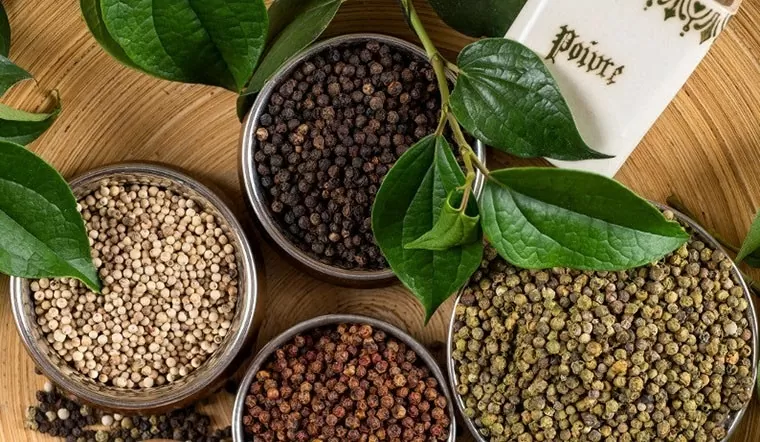Vietnam is the largest pepper exporter to the United States
According to the International Trade Center (ITC), pepper exports
from the world's main producing countries have contradictory patterns.
In the first half of 2024, the two leading exporting countries in the
world, Vietnam and Brazil, decreased by 6.8% and 6.0%, respectively. In
the same direction, Malaysia's exports also decreased by 8.1%, while
Indonesia and India's exports increased by 48.3% and 34.1%.
 |
| Vietnam is Brazil's largest pepper buyer |
Compared
to the same period in 2023, in the first 6 months of 2024, the average
FOB price of black pepper and white pepper in most main producing
countries increased sharply, except India. Specifically, the average FOB
price of black pepper increased by 27% and the average FOB price of
white pepper increased by 14% over the same period last year. The
strongest increase was recorded in Brazilian black pepper, followed by
Vietnam and Indonesia.
Global
pepper trade from the beginning of the year until now recorded a
decrease of more than 20% compared to the same period in 2023. The
largest decrease came from the Chinese market, down 85%, mainly because
this country reduced imports from Vietnam.
The United States
is the largest pepper consuming market in the world, of which Vietnam
is the largest exporter to the United States accounting for 75.8%,
followed by India accounting for 8.5%, Indonesia accounting for 8.4%.
and Brazil accounts for 4.0%.
The price of Brazilian pepper exported to Vietnam increased by 19%
In
Brazil, the harvest ended in the states of Espírito Santo and Bahia
with yields 10% lower than last year due to the impact of the El Nino
drought phenomenon at the beginning of the year.
Brazil
is continuing to harvest in the Espirito Santos region and in November
in the Para region, it is estimated that the whole country will collect
about 60 thousand more tons. Climate change (La Nina) will affect the
production of Brazilian pepper in the coming months.
According
to some farmers in the Espirito Santos region, the harvest in 2024 may
be 25-30% lower due to the heat causing most of the first cotton to fall
and the ratio of fruit set to buds of the second and second cotton
blooms. Phase 3 is quite low so it is expected to only reach about 70%
compared to last year. Overall, the whole country in 2024 may decrease
by 20-25% compared to 2023.
In
the first 6 months of 2024, Brazilian pepper exports reached 37,181
tons, turnover reached 141.7 million USD, down 6.0% in volume but up
21.4% in value compared to the same period last year.
Brazil's
main export markets include: Vietnam reached 5,910 tons, accounting for
15.9%, down 21.5% over the same period. Next is the market reaching
India: 3,892 tons, accounting for 10.5%, an increase of 47.2%; Pakistan
reached 3,703 tons, accounting for 10.0%, an increase of 63.3%; Senegal
reached 3,659 tons, accounting for 9.8%, down 19.6% and Morocco reached
3,565 tons, accounting for 9.6%, down 9.5%...
Exports
to Egypt, the Netherlands, and Mexico decreased while exports to the
UAE and Germany increased, especially exports to the United States
increased by 701.1% to 1,402 tons, however compared to the same period
in 2022, it reached 3,002 tons. export volume decreased by 53.3%.
The average Brazilian pepper export price
in the first 6 months of the year reached 3,810 USD/ton, up 29.3% over
the same period last year, of which the export price in June increased
by 31.1% compared to January 2024. Notably, the average price of
Brazilian pepper exports to Vietnam reached 3,488 USD/ton, an increase
of 19.0% over the same period in 2023 and this is the lowest price among
the top 15 importing countries, lower than the UAE. : 4.0%; India:
7.8%; Netherlands: 8.8%; United States: 9.2% and Germany: 17.5%.
In Vietnam, Ms. Hoang Thi Lien - President of the Vietnam Pepper and Spice Association - said that Vietnam's pepper exports
in the first 6 months of 2024 reached 142.5 thousand tons compared to
the year's harvest. 2024 will reach about 170 thousand tons, the
remaining output is estimated to reach about 28 thousand tons.
The
domestic pepper market in the early days of August was still trading
around the 147,000 - 150,000 VND/kg mark although many comments about
supply shortages in the country and the world were still being made.
Currently, both sellers and buyers are waiting for the latest market
movements when Indonesia is expected to harvest the pepper crop in
August.
Some
experts continue to comment that signs of supply shortage compared to
demand will continue to be recognized and reflected by the market in the
coming time until the end of the season. Currently, Brazil has 3
sterilized pepper factories and is building 2 more factories and will be
completed in 2025. In the future, Brazilian pepper will compete better
with Vietnam, so imported supply will less, so Vietnamese businesses
need to proactively source raw materials.
According to Congthuong.vn














